When I posted about navy blue Oscar dresses, Ann asked me, quite politely, whether High WASPs should be discussing such silliness. And the answer is, “Of course not.” We are supposed to write about matters of intellect and refinement.
Lucky for you all, my family knows when I need help. Herewith a post my from my father, the professor, reviewing “The Age Of Innocence” from a personal perspective. He addresses both Edith Wharton’s novel, and Scorsese’s movie of the same name. Any goofy editorial notes are mine. But you knew that already.
I will continue to write here about style. One does what one must. Thank you for your forbearance. And Dad, thanks for the substance, and for the fun discovery towards the end of your review.
The Age of Innocence: Wharton and Scorsese
My grandmother was born about 1870, married a wealthy New Yorker, was something of a grande dame (though not all that flamboyant), and died in her nineties, having lived a life quite like those depicted in “The Age of Innocence,” Edith Wharton’s novel and Martin Scorsese’s film. The novel and the film are both resonant.
At the turn of the century, when Wharton lived in the Berkshires, my grandmother spent a few summers there. Maybe they knew each other or met at a party. Yet there was a big difference between them. Edith Wharton led a complicated life and saw what was going on beneath the smooth surface of things . My grandmother, whose husband died in his early fifties, lived on as a widow for many decades, inhabiting to the end a world of imagined innocence. The pain and the comedy of that world equally passed her by. Or that is how it seemed to me.
That brings me to “The Age of Innocence” and New York in the 1870s. Wharton published her novel in 1920, fifty years after the fictional events took place and after World War 1 had overturned a complacent world. This story of Newland Archer’s infatuation with the glamorous Ellen, Countess Olenska, and his marriage, against his own deepest instincts, to the far more proper May Welland, is a tale of social inhibition and frustrated desire. But it is also a comedy of manners, informed by Wharton’s opulent imagination and narrative power.
Wharton introduces Mrs. Manson Mingott, grandmother to Ellen and to May, as a huge Cycladic idol, a female Falstaff, her plus plus plus size marking her as a life force and as the moral center of the story. The baroque hilarity of Wharton’s prose, set of course in an era before abundance of flesh came to seem a moral failing, could not be bettered. Mrs. Mingott, vastly corpulent, is a ruined Pompeii, still very grand though covered by the ashes of time:
“The immense accretion of flesh which had descended on her in middle life like a flood of lava on a doomed city had changed her from a plump active little woman with a neatly-turned foot and ankle into something as vast and august as a natural phenomenon. She had accepted this submergence as philosophically as all her other trials, and now, in extreme old age, was rewarded by presenting to her mirror an almost unwrinkled expanse of firm pink and white flesh, in the centre of which the traces of a small face survived as if awaiting excavation.”
I can only imagine, enviously, what it would be like to be able to write like that.
True, the comedy yields to sadness as the story works its way to a melancholy end. Ellen has gone back to Europe, though not to her disreputable husband; May has died after twenty-five years of marriage; and Archer arrives in Paris with his grown son, who has arranged — in the liberated manner of the new generation – for them to see Ellen. But Archer asks his son to visit the countess in her upper story flat without him. On a park bench, looking upward at her window, Archer imagines people in the room, among them “a dark lady, pale and dark” – then realizes, speaking to himself, “it’s more real to me here than if I went up.” A servant appears and closes the shutters. Archer walks slowly back to his hotel by himself. Even in this melancholy close, there remains a trace of the comic. Silly man, you think, what is the matter with him? He has traded in the flesh and blood of the actual world for fantasy: Ellen is more real as a nostalgic memory than as a living person.
However much the life of 1870s New York depended on strict codes of social behavior, however much it subdued real feelings in favor of conventional manners, Wharton understood that this way of life – which she had herself renounced, divorcing her mentally troubled and unfaithful husband; briefly keeping up an affair, already several years ongoing, with the bisexual Morton Fullerton; and moving to France where she died in 1937 — could seem like a safe harbor.
Not long after arriving in New York, Ellen says to Newland : “I want to feel cared for and safe.” And, “being here is like–like–being taken on a holiday when one has been a good little girl and done all one’s lessons.” And, of the house where she’s living, “To me it’s like heaven.” And, later, in a letter to Newland from the Van der Luydens’ very grand country house: “I feel myself so safe here.” This is not just a comic misperception of how things really are. Safety may lie in not knowing all that could be known. At least I’m sure that’s what my grandmother felt; and, growing up in that orbit and being a good little boy who did all his lessons, I suppose that in a way I did, too.
Scorsese’s Age of Innocence
Scorsese’s “Age of Innocence” surprised those who expected him to stick to the mean streets. What was this muse of the down-and-out doing in the upper class environs of 1870s New York? We look for consistency in our artists and writers and directors because consistency makes it easier to understand them. One film critic compares the social codes of Wharton’s people in Scorsese’s treatment to those of the Mafia. Even Scorsese seems to want to be more like himself than he seems: in an interview he described how he saw the story: “What has always stuck in my head is the brutality under the manners. People hide what they mean under the surface of language.” I hesitate very much at “brutality” though not at the claim that the surface of things fails to match up with the reality. It’s best to take the film on its own terms and not try to shape it into another “Goodfellas,” whatever Scorsese himself may think. Intention is not everything.
The film captures all of the pain in Wharton’s novel but less of the comic side. It could hardly do otherwise because so much of the comedy lodges in the dispassionate commentary of Wharton’s narrator. In the film, Joanne Woodward’s cool and witty voice-over fills in for Wharton’s as well as could be, but there is no recreating all the narrative flashes of wit and virtuoso descriptions that fall outside the ebb and flow of action and dialogue. In the novel, action and commentary are seamless. In the film, too much comic commentary would subvert the mood. And there is no way to reproduce visually Wharton’s vision of Mrs. Mingott as a ruined Pompeii. If this were heard as a voice-over, the actual sight of Mrs. Mingott would be an anti-climax instead of the visual treat that it is, not without comic flair — Miriam Margolyes plays the role wonderfully – but without the baroque overlay of Wharton’s prose. The novel and the film require different degrees of self-distancing.
At the same time, Scorsese and his film writer Jay Cocks add much of their own to the film, sometimes in the interests of accessibility, sometimes in a spirit of exuberant invention. In the novel, Archer’s son is named Dallas; in the film he is Ted. Dallas is a family name of the sort favored for male children in 1870s New York. Some of Wharton’s players are Lawrence Lefferts, Manson Mingott, Sillerton Jackson (a memory of Morton Fullerton here?) as well as Newland Archer and Dallas Archer. But viewers would probably have thought of the Cowboys had Archer’s son been named Dallas. This is an easy alteration, among several, to enhance clarity. More substantial and very engaging is Mrs. Mingott’s gaggle of Pomeranians, perhaps suggested by Wharton’s description of Mrs. Mingott’s “little hands” nestling “in a hollow of her huge lap like pet animals.” Pomeranians, Queen Victoria’s favorite dog, are the perfect choice for Mrs. Mingott and her sumptuous surroundings. Mozart is said to have dedicated an aria to his pet Pomeranian.
But the film’s most inventive move, unnoticed so far as I’ve seen by the critics, lies in its casting of the countess and May Welland, Michelle Pfeiffer as Ellen, Winona Ryder as May. In conventional iconography, made familiar by Sir Walter Scott, the blonde heroine is the virtuous innocent; the dark heroine, the dangerous and passionate outsider. Scorsese reverses these types. (Ed. note: Scott wrote Ivanhoe. I read it when I was 12. I remember nothing.)
In the novel, the “dark lady, pale and dark,” of Archer’s imagining reminds young Miss Blenker, at whose house the countess has been staying, of the dark and sultry actress Mrs. Scott Siddons: “I do love the way she does her hair, don’t you?” … Doesn’t she remind you of Mrs. Scott-Siddons…? ” In the film, Miss Blenker says instead: “I do love the way she does her hair, don’t you? It reminds me of Sir Walter Scott,” evidently to cue a savvy audience that fair and dark have been exchanged. (Did Scorsese and Jay Cocks intend this? If they didn’t — and it seems almost certain that they did — it’s an instance of genius stumbling onto good answers to tactical problems.) (Ed. Note: Are we surprised that it’s all about the hair color?)
The strawberry blonde, blue-eyed Michelle Pfeiffer as Ellen wears her hair in artful ringlets, like Scott’s Saxon heroine Rowena (in Ivanhoe). The dark-haired, brown-eyed Winona Ryder as May supplants the virginal blue-eyed heroine of the novel, to whom Archer sends a box of white lilies-of-the valley each day, whose wind-blown hair in one scene glitters “like silver wire,” and who wears her hair (like Michelle Pfeiffer’s), in “accumulated coils.” The reversal works beautifully: the innocent May Welland is an adroit schemer; the exotic Ellen Olenska, something of a naïf. Surface and reality are confused. Things are far off key. Nothing is quite how it seems or the way we expect it to be. On the one hand Scorsese transforms the novel; on the other he reinforces its overriding theme.
I’ve not looked this closely at a film before. Add it all together – script, technique, settings, soundtrack, costumes, hairdos, everything – and “The Age of Innocence” must be one of the best ever. Its sole Academy Award was for costume design.
*******
The differences between “The Age of Innocence,” the novel, and “The Age of Innocence,” the film, are differences between art forms, the one, in this case, quite as good as the other.
*******
Images: Amazon (yes, that is the Kindle edition. What?), Allstar Pics

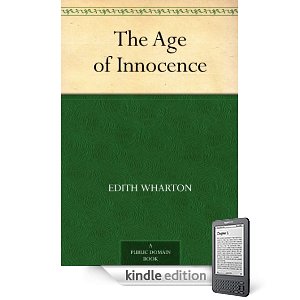
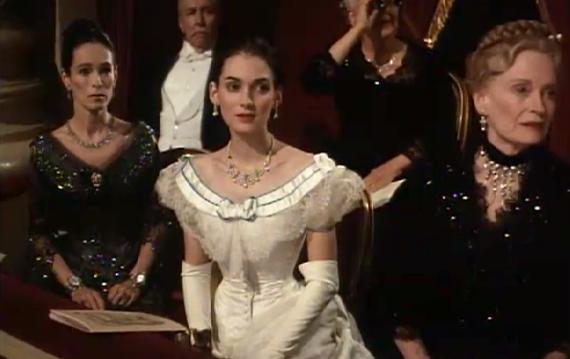
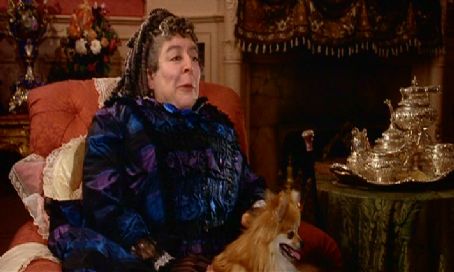
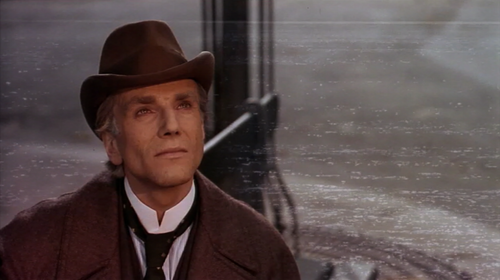
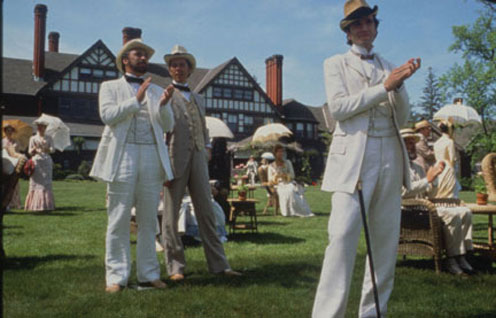
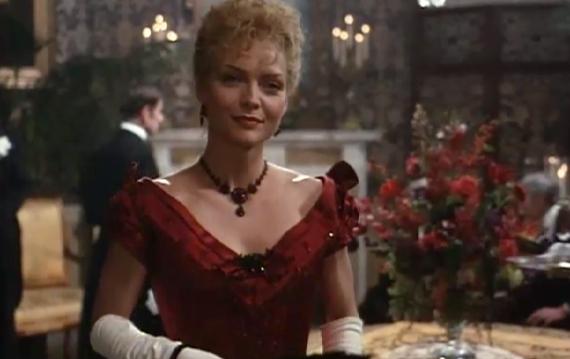
37 Responses
Thank you for a fascinating post. Now you’ve inspired me to go re-read some Wharton. The Buccaneers is my personal favorite, but I believe I will have to go hunt down a copy of the Age of Innocence.
Perhaps Lisa would allow you to contribute a regular series contrasting literature with its film version? It’s interesting to see how film makers attempt to capture not just the imagery of the writing, but also the tone.
Going in a completely opposite direction of Wharton, I thought the Coens did an admirable job with McCarthy’s “No Country for Old Men”. But how you could possibly capture the violently beautiful and strange language of “Blood Meridian” without devolving into a gorefest? Perhaps the same for Wharton’s subtle comedy – it simply can’t be captured on film?
Great post! I read so much Edith Wharton in college – she is such a favorite of mine. Age of Innoncence, House of Mirth – so many wonderful pieces.
Ahhhh, both the book and movie are personal favorites. There were so many subtleties in the film that deserved a second glance. The DETAILS were exquisite as well. Everything was spot on. The book? A classic. Great post!
I saw Scorcese’s film in college, a screening for a screenplay writing class I was taking, and it inspired me to read some Wharton, too.
I love the cleverness, the dexterity of language in both versions, but I think I agree with you that a lot of the humor is lost in the film–which isn’t necessarily a criticism. The film wallows in its moodiness gracefully.
Any chance, Professor C., that you’d consider a regular appearance here?
I loved reading your father’s post. I wish he had been one of my professors although there was no spot for me at Stanford…haha. Age of Innocence is one of my all time favorites…I still remember being entranced while reading it over 25 years ago!!! I think it’s time to read it again. Please thank your father!
Thanks for a great and insightful review. My affection for this film had more to do with my serious crush on Daniel Day-Lewis than an appreciation for the wonderfully cryptic elements of novel and script.
I would only add that, in my view, Scorsese’s notion of “the brutality under the manners” is spot on, especially for the women of the times. We have only to take a brief look at women’s history to suss this out.
Thanks so much for your offerings here!
Lisa, what a joy to discover on this bright but cold New England day another post from Professor C! And on one of my favourite books at that.
At my fancy-pants little ivy school, we were blessed with so many wonderful professors. Reading your father’s thoughts on Wharton made me long for those halcyon days and wish that he had been a member of our academic pantheon.
I echo my friend CDG in wishing for a regular (however that might be defined) appearance from Professor C!
And please never stop writing about pretty navy blue dresses. Although such discussiions may appear to be substance free(my own father’s term that I love), just as in Edith’s world there is much more below the surface.
One of my favorite novels, another being House of Mirth (“The heart of the wise is in the house of mourning, but the heart of the fool is in the house of mirth,” from the Bible). Can your father just sign onto a weekly lecture commitment via Priv. so we never have to worry again about our degenerating brains?
Thanks, Dad. And I for one see the parallels between the Age of Innocence and your daughter’s deconstruction of present-day garb.
PS Why does it take so long for your posts to show up in my Google reader? It hasn’t yet appeared – I found this only by clicking over to the website. Is there any way to make it show up in a more timely fashion (so to speak)?
i have to pipe up in defense of bawdy old sir john’s image, for reasons which escape me at the moment (who, at 32, sides with falstaff? or is it that we all do?); while mrs. mingott is a fantastic glutton, has she the sexual appetite of a female falstaff? one mustn’t forget the lechery!
i love your analysis of the film, professor c.; it brings back fond memories of joss marsh’s dickens and film course, and the marvelous way she deconstructs the mise-en-scene in christine edzard’s little dorrit.
on a more frivolous note, as i’ve told lisa before, my family dentist was named ivan ho. we treasured his office’s toothbrushes.
I enjoyed reading your brilliant analysis of The Age of Innocence. I am quite fond of the film, as well as the book.
I always thought that Michelle Pfeiffer and Winona Ryder were miscast. Not that their roles needed to be reversed, but that they were both too tied to 20th century pop culture to be believable in any period piece. Daniel Day-Lewis was perfect, though.
A thoroughly enjoyable post! I just reread all of Wharton last summer. May we look forward to future reviews?
Does anyone remember the details of Ivanhoe? Seriously, great review of one of my favortie novels and movie adaptations. Thank you Professor C.
Lisa, please keep writing about fashion and navy blue and the Academy Awards. After all, if one had the opportunity to dress for the red carpet, one would want to be appropriate.
Professor C., thank you for a wonderful post that brought back a lot of memories! I watched The Age of Innocence as a teenager. Like all teenagers, I was deeply judgmental and fancied myself a bold soul who would of course defy social conventions to be with the person she loved, so I didn’t find Newland very sympathetic. The final scene simply confirmed to sixteen-year-old me that he was a drip who didn’t deserve Ellen. I was also frustrated that the movie seemed to portray Newland’s choice to marry May as inevitable instead of as something Newland could have changed had he possessed the necessary strength of will. I felt the film was asking us to view Newland’s fate as a tragedy beyond his control rather than the result of his own decisions.
But when I read the Wharton novel in college I was startled to discover what you so beautifully articulated, that the novel was witty and funny in a way that the film didn’t capture. Wharton’s narrator was on to Newland and knew his fate was not inevitable. At the time I thought that the movie was simply not as good as the book but what you wrote here makes me want to re-watch the movie to see if my initial judgment still holds.
Now I want to clear my schedule to re-read Wharton novels! If you are so inclined I would love to hear your thoughts on The House of Mirth.
I have cried my heart out during several viewings of House of Mirth and will now look forward to Age of Innocence.
I appreciate the words and concept of “feel myself so safe here”–which helps me to explain how I imagine Princess Diana in the back of a quiet solid chauffeur driven car. I apologize for the divergence but I have tried to explain the concept of -SAFE but not safe…..having rarely felt it myself, but knowing it is, but an illusion of safety.
On another note completely, approaching the age of 58, as an attractive, 5’11”–size 16–I have thought how wonderful it would be to live in the late 1800’s when beauty combined with substantial size was considered an asset! I need a time machine-NOT SPANX
Thank you very much, Professor C! And thank you, Lisa, for featuring this guest post.
It was an enormous pleasure to see something I treasure very highly – I studied literature at university – pop up so unexpectedly here. In fact I’d love it to pop up much more often since I never gave up this early passion regardless of any current occupation. Most wonderful is of course how Wharton’s observations relate to the enlightened musings about society on this blog. Much fun after a hard day!
I loved this, having read and enjoyed the book several times. I saw the film just once. Now I want to see it again. Thank you for the discussion!
I adore Wharton. This post made my day so much better – my day was REALLY stressful.
It has been so long since I’ve seen this film…I must watch it all over again now. Recently viewed House of Mirth, a Wharton novel I have not read. The film, however close to book it may have been, kept me thinking for days after.
Very nicely done, Professor C. This sort of thing engages us tremendously and we’d like to see more of you around here. I thought The Age of Innocence a wonderful book, intricate, nuanced and beautifully paced. And it’s the pacing where the film version, I recall, annoyed me a bit – so nearly excellent, but perhaps a bit ponderous, guilty of over-romanticism in lingering camera shots where a fleeting suggestion would have been more true to Wharton’s intent.
How I enjoyed your commentary, Professor C.! Perhaps “brutality” is too harsh, but the creation, enforcement and eventual desuetude fascinate me. Fifty years, then a hundred: we cannot attain much perspective in our short lives, but you have so aptly captured the currency and antiquity of this work.
And the tabloid press wondered what it meant when Britney Spears grabbed those scissors to shear herself.
Thanks so much, everybody. Ann: I think Les Liaisons Dangereuses (do you know it?) is brutal; Age of Innocence, not quite, but I take the point. Lauren: (sorry we never crossed paths at LSJU): it’s true, unlike Falstaff, Mrs. Mingott has gone beyond the sexual game. Mise: I agree, it’s slow. I still think it works, but that may have something to do with watching on DVD and therefore having to take it slowly, pausing to see what’s what. Sitting in a theater, which I suppose I once did, I may have felt the same way.
With your encouragement, I’m thinking about doing an occasional Wharton-fest, novels & films. Wouldn’t be weekly, just once in a while, when Lisa has some extra space. Prof. C.
Thank you for this wonderful post! There is such beauty in your father’s words. This post takes me back to my college English classes. xoxo
Thank you all so much. Professor C. and I have discussed. The good news? He has agreed that a sporadic Wharton ‘seminar’ would be fun. The bad news? Now I have to go read those other books, House of Mirth, etc. I used to adamantly refuse to read anything from the years between the 17th and 20th century. For you all, however, I will enter new territory. Oh, and where there’s a movie Professor C. will cover that too.
We’re thinking once every 6 weeks or so. And I will post a small heads up, a week in advance, both for those who want to read along, and for those who want to run far away. There is no implied virtue in liking literature from other eras. Again, just sharing a culture that has preferred more often to remain silent.
Thank you everyone. You warm my heart. Which is not very High WASP to say, but I’m learning:).
Lisa,
Enjoyed the post of your father.
Love his writing style.
I do enjoy your website. Authentic. Doesn’t get any better than that.
Best –
Ann
What a wonderful thing to say. I would chose authentic over most everything.
Professor C.
I’ve not read any Wharton but I love well assembled words and I enjoyed yours. I would suggest that you start your own blog but since Lisa lends hers to you, please write something often.
Dustin
Lisa what a testimony to your Father’s intelligence to provide us with this wonderful review. I enjoyed it tremendously.
From the movie, Scorsese’s the costumes, just magnificent!
xoxo
Karena
Art by Karena
What a brilliant and beautifully written post from your dad. I have seen The Age of Innocence but my memory’s so bad I can barely remember it now. This post has inspired me to get a copy. Have a great weekend xx
Ok this is just too weird- I watched the Age of Innocence again the other day and thought of you LPC and now your dad writes this!
I say, Professor, well done! Most excellent post, and highly thought-provoking. I admire how you begin with your grandmother and then take us, your fortunate readers, on a marvelous ride through Wharton and Scorcese. Thank you. Reggie
PS, the offer of a tie or two still stands, by the way…
I teach The Custom of the Country regularly and show Scorcese’s film as a complement. I’ve even edited Innocence–must have been before I gave birth to my son–but never made the conection that Newland Archer’s son and mine share a first name! To me it’s a wonderful Scottish name but does (sigh) work well with American football. But now that there’s a literary connection, well . . . I couldn’t be happier! Go team!
I believe either Scorcese or Jay Cocks described Age as “the taking of life, without blood”…which was such a beautiful way of comparing the “normal” scorcese picture to this one…
That is a lovely phrase.